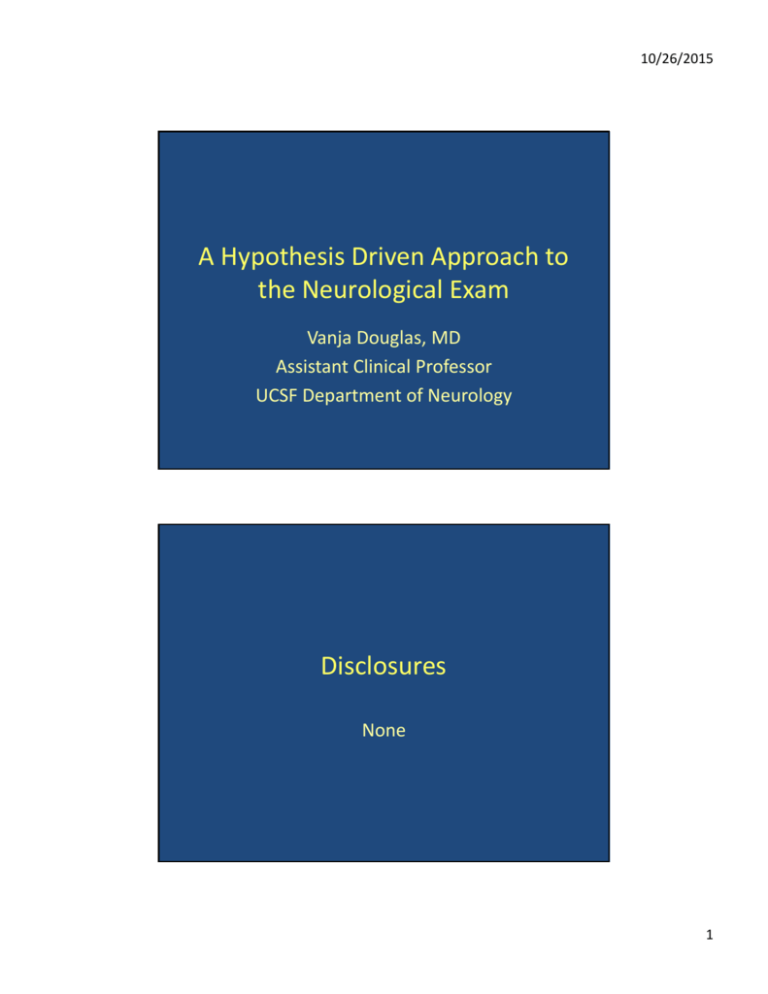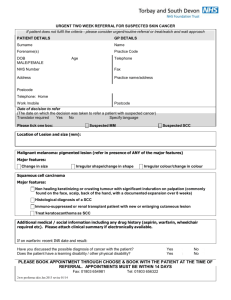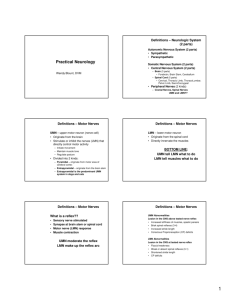slides
advertisement

10/26/2015 A Hypothesis Driven Approach to the Neurological Exam Vanja Douglas, MD Assistant Clinical Professor UCSF Department of Neurology Disclosures None 1 10/26/2015 Purpose of Neuro Exam • Screen asymptomatic patients • Screen patients with symptoms that could indicate a focal neurologic lesion (e.g. back pain, headache, seizure) • Localize the lesion in patients with neurologic deficits – Generate a differential diagnosis – Decide what test to get next (e.g. brain MRI, spine MRI, EMG/NCS, CK) Typical “Screening” Neuro Exam • Mental Status: Level of alertness, orientation, attention, language, memory • Cranial Nerves: II through XII • Motor: Bulk, tone, power in all muscles in both arms and legs • Sensory: Light touch, vibration/joint position sense, pain/temperature, Romberg • Reflexes: Biceps, triceps, brachioradialis, knees, ankles, plantar response • Coordination: Finger‐nose‐finger, heel‐knee‐shin • Gait: Observe gait, include tandem, heel, and toe walking 2 10/26/2015 High Yield Screening Neuro Exam • Mental Status: language, orientation, and attention • Cranial Nerves: visual fields, eye movements, and facial symmetry • Motor: Pronator drift, finger and foot taps, finger extensor and extensor hallucis longus power • Sensory: Romberg • Coordination: Finger‐nose‐finger and heel‐knee‐shin (can replace HKS with gait) • Reflexes: Biceps, knees, and ankles • Gait: Observe gait (base, stride, posture, arm swing, turn), tandem Case Scenarios HYPOTHESIS‐DRIVEN NEURO EXAM 3 10/26/2015 Patient #1 • A 23 y/o woman with a history of migraine headaches is admitted to the hospital with left leg cellulitis. On hospital day 2, she complains of a new headache. She says it’s different from her previous migraines because it is “much worse” and is wondering if she needs an MRI. Headache Suspected localization • Focal brain lesion Other potential presenting symptoms • • • • Seizure Unilateral weakness Unilateral numbness Dysarthria 4 10/26/2015 Hypothesis‐Driven Neuro Exam Patient #2 • A 74 y/o former ballet dancer is found by the police wandering in the street. He is brought to the ED where he is agitated and confused with rambling incoherent speech. 5 10/26/2015 Altered Mental Status Suspected localization • Focal brain lesion • Diffuse metabolic process Hypothesis‐Driven Neuro Exam 6 10/26/2015 Patient #2 Exam • • • • Awake, alert Rambling, fluent but incomprehensible speech No commands Absent blink to threat on right Inferior Division MCA Stroke 7 10/26/2015 Patient #3 • 57 y/o man with afib transferred to UCSF for management of status epilepticus. He presented to another hospital comatose with bilateral jerking movements of the arms and legs. Coma Suspected localization • Bilateral hemispheres • Brainstem 8 10/26/2015 Hypothesis‐Driven Neuro Exam Patient #3 Exam • • • • • No eye opening to pain R pupil 6 mm, unreactive, L pupil 4 ‐> 2 mm Absent R corneal reflex Absent VOR to the R No withdrawal to pain on the left 9 10/26/2015 Basilar Artery Occlusion Patient #4 • A 32 y/o woman presents with tingling in the hands and feet that progressed to diffuse weakness in the arms and legs over four days. She is now so weak she can no longer sit up. 10 10/26/2015 Diffuse Weakness Other potential presenting symptoms Suspected localization • High spinal cord • Neuropathy • Neuromuscular junction • Myopathy • • • • Diplopia Dysarthria Dysphagia Respiratory failure Localization of Weakness Pattern of weakness Tone Bulk Reflexes Sensory Loss Upper Motor Neuron Pyramidal Spastic Normal Increased Varies Anterior Horn Cell Pyramidal or myotomal Spastic or normal Atrophy Increased or decreased None Peripheral Nerve In distribution Normal or of root or reduced nerve Atrophy Decreased Prominent Neuromuscular Junction Diffuse Normal Normal Normal (myasthenia) or Absent (botulism) None Muscle Proximal > Distal Normal Normal or patterned atrophy Normal None Other Fasciculations Ptosis and ophthalmo -paresis 11 10/26/2015 Patient #4: Exam • Diffuse weakness throughout both arms and legs in both flexors and extensors • No sensory level • Decreased pinprick sensation in the feet • Diffusely absent reflexes Guillain‐Barre Syndrome 12 10/26/2015 Patient #5 • A 53 y/o man with HIV and a history of laryngeal cancer presents with back pain and urinary urgency. Back Pain Suspected localization • Spinal cord Other potential presenting symptoms • Urinary or bowel incontinence • Bilateral leg weakness or numbness 13 10/26/2015 Hypothesis‐Driven Neuro Exam Patient #5: Exam • Decreased EHL power bilaterally • Spasticity in both legs • Sensory level to pinprick at T5 14 10/26/2015 Epidural Abscess 15 10/26/2015 Summary • High yield screening exam • Hypothesis driven approach to: – Suspected focal brain lesion – Altered mental status and coma – Diffuse weakness – Suspected spinal cord lesion Acknowledgements Hooman Kamel Andy Josephson Dan Lowenstein Kamel et al, A randomized trial of hypothesis‐ driven vs screening neurologic examination. Neurology Oct 2011, 77(14) 1395‐1401. • Images from Wikimedia Commons • • • • 16 10/26/2015 Bonus Case • A 30 y/o woman with lupus, APLAS, and history of endocarditis on gentamycin presents with acute vertigo. Vertigo Suspected localization • Brainstem • Cerebellum • Inner ear Other potential presenting symptoms • Imbalance 17 10/26/2015 Hypothesis‐Driven Neuro Exam Patient #4: Exam • Left beating nystagmus in left‐gaze only • Positive head thrust test to the right 18 10/26/2015 Gentamycin Toxicity 19










